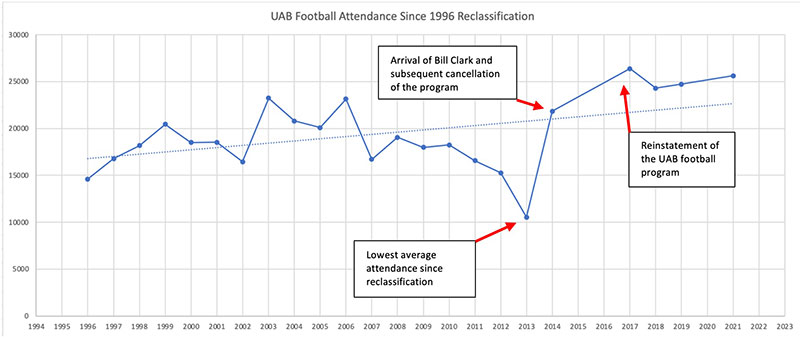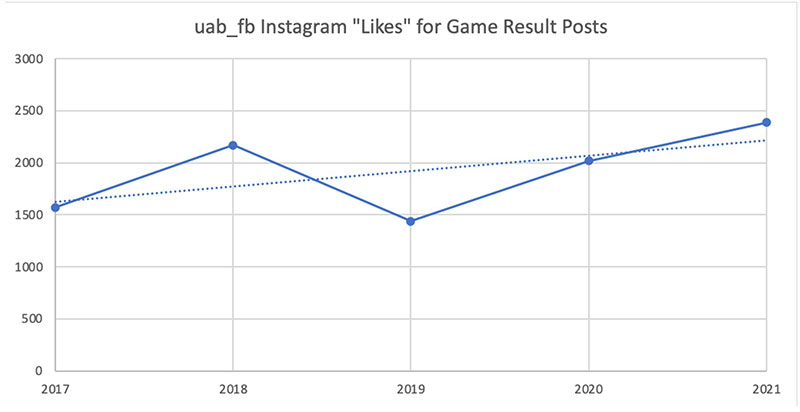On the morning of June 24th, UAB Blazer football fans awoke to news they likely were not expecting to hear for a long time. Bill Clark, undeniably the program’s most successful head coach, had announced that he was retiring due to long-lasting chronic back issues.
“Retiring as the UAB head football coach is the hardest decision I’ve ever had to make,” Clark wrote in a statement, “but my future health and well-being depend on it” (Scarbinsky).
Clark, who had compiled a record of 49-26 (65.3% winning percentage) during his time commanding the Blazers, won multiple conference championships and bowl games, two distinct achievements fans had been yearning for year after year (UAB Sports). Since the Blazers joined the class 1-A classification in 1996, the program struggled to gain relevance and routinely put together disappointing season after season. Everything changed when Clark left Jacksonville State to take the reins in 2014. Under Clark, UAB became a Group of 5 power, even striking fear into the occasional SEC team that would dare schedule them. The question now is simple: how does UAB maintain the relevance they’ve gained under Clark without him?
The Pre-Clark Era of UAB Football
Between the 1996 reclassification and the 2014 arrival of Bill Clark, head coaches Watson Brown, Neil Callaway, and Garrick McGee led the program. During those years, the team sulked to 15 losing seasons across 18 years and only appeared in a single bowl game, losing to Hawaii in the Hawaii bowl back in 2004 (Wikipedia). Not only was the team abysmal, but attendance was a yearly frustration too.

[1]
Rock-bottom and Re-birth
Shortly after reclassification, the Blazers experienced fluctuations in attendance as the team went through the growing pains most new I-A teams initially go through. At the beginning of the 2010s, the program experienced a significant downturn in attendance. 2013, most notably, saw an average attendance of nearly below 10,000 fans per home game. However, Clark arrived on the scene in 2014 and instantly turned the team into a competitive product, going 6-6 in his first season. The response to the Blazers’ improved play was the highest average home attendance since 2006 and the third-highest since reclassification. However, the bowl-eligible team received shocking news from school president Ray Watts that the football program was being shut down.
"When considering a model that best protects the financial future and prominence of the Athletic Department, football is simply not sustainable," Watts stated in December 2014 (Chicago).
After an uproar from the fan base and city of Birmingham, Clark and the Blazers were given a second chance at life. In 2017, the program was back on the field, picking up right where it left off in 2014. The team improved to an 8-5 record and reached their first bowl game in 13 years (Wikipedia). Attendance since Clark’s arrival in 2014 has seen steady growth as the on-field product has drastically improved. The Blazers’ success and revamped energy around the program helped spearhead the all-new Protective Stadium in the heart of downtown Birmingham. In addition to attendance, social media engagement has seen a steady uptick over the Clark era.

[2]
The Instagram handle @uab_fb was created in 2014 at the onset of the Clark era and struggled to gain traction as most posts failed to surpass 100 likes. However, after the program’s revival, social engagement increased substantially and has continued an upward trend through the 2021 season.
Where does the Program Turn Without Clark?
The overall growth the program has seen under Clark is undeniable, but where do the Blazers turn without him at the helm?
Hire within the program
Fortunately for the Blazers, offensive and defensive coordinators Bryant Vincent and David Reeves have coached with Clark since 2014. Because of their history, both coaches certainly understand of the culture Clark has been able to implement over his six seasons with the program. As impressive as Vincent has been running the offense for the Blazers, Reeves should be the choice the athletic department rolls with for the 2022 season. During Reeves’ time with the team, he has been a two-time Broyles Award nominee and has led UAB’s defense to three top-10 finishes in total defense from 2018-2020 (UAB Sports). If there is anyone who can pick up where Bill Clark is leaving off, it has to be Coach Reeves.
Use Protective Stadium as leverage and enhance scheduling
Protective Stadium officially opened in October 2021 for its inaugural UAB football game vs. Malik Willis’ Liberty Flames. The result wasn’t pretty, but the lights shining down over the city of Birmingham certainly stole the show. Protective Stadium is one of the newest football venues in the country and rests in a unique spot. With views of the skyline and airport flight path, Protective offers fans of all teams, even Alabama and Auburn, a special opportunity to watch football in the middle of a downtown area. The program should take advantage of this relatively distinct situation and market Protective’s unique location. Additionally, the program should push to add an extra Thursday or Friday night game to their annual schedule. This way, fans of other large teams in the state of Alabama can come to support the Blazers without having to pick and choose what to do on their Saturday.
Use Birmingham as a recruiting tool
It’s no question that the city of Birmingham has been on the rise over the past few years. The sports industry has been thriving with the addition of Protective Stadium, the Birmingham Squadron, the renovations to Legacy Arena, the 2022 NCAA Tournament, and especially The World Games 2022. According to AL.com, The World Games 2022 are projected to have an economic impact of $256 million on the city of Birmingham (Wright). The excitement around sports in Alabama is already at a fanatic temperature when you consider the impact of Alabama and Auburn fans, but now with Birmingham taking sports to a new level, recruiting high school players to the city should become progressively easier. If the program can utilize the sports growth in the local area through the pitches they make to incoming freshmen, they will be putting themselves at an advantage when it comes to luring high-profile players away from higher caliber teams.
The loss of Bill Clark certainly stings, but there are many reasons to remain excited about the trajectory of this program. With attendance and social engagement on the rise, UAB finds itself in a better situation than most teams who lose their beloved coach.
This blog post was written by Zach Chandler. You can learn more about Zach Chandler on LinkedIn
Sources
- Scarbinsky, Kevin. (2022, June 24). Bill Clark retiring as UAB head football coach. AL.com. https://www.al.com/uab/2022/06/bill-clark-retiring-as-uab-head-football-coach.html
- UAB Sports. Bill Clark. UAB Sports. https://uabsports.com/sports/football/roster/coaches/bill-clark/1616
- UAB Blazers football. (2006, September 3). In Wikipedia. https://en.wikipedia.org/wiki/UAB_Blazers_football
- Bowl-eligible UAB shuts down football program: report. (2014, December 2). Chicago Tribune. Retrieved June 25, 2022, from https://www.chicagotribune.com/sports/college/chi-uab-football-program-20141202-story.html
- UAB Sports. David Reeves. UAB Sports. https://uabsports.com/staff-directory/david-reeves/280
- Wright, Barnett. (2022, January 6). How The World Games 2022 will forever change Birmingham. AL.com. https://www.al.com/news/birmingham/2022/01/how-the-world-games-2022-will-forever-change-birmingham.html#:~:text=The%20games%20will%20take%20place,%24256%20million%20in%20economic%20impact.
- [1] See UAB Blazers football (2006). Year by year game results provide home and away attendance.
- [2] Data obtained through the UAB football Instagram page (@uab_fb)
